Influences of High-Speed Train Speed on Tunnel Aerodynamic Pressures
Abstract
:1. Introduction
2. Numerical Simulation
2.1. Governing Equations
2.2. Numerical Simulation Method
2.3. Tunnel and Train Models
2.4. Computational Domain
2.5. Boundary Conditions
2.6. Sliding Mesh Method
2.7. Grid Generation
2.8. Layout of Monitoring Points
3. Validation
4. Results
4.1. Typical Stages of Time History of Aerodynamic Pressures
4.2. Aerodynamic Pressures in Stage I
4.3. Aerodynamic Pressures in Stage II
4.4. Aerodynamic Pressures in Stage III
5. Conclusions
Author Contributions
Funding
Institutional Review Board Statement
Informed Consent Statement
Data Availability Statement
Acknowledgments
Conflicts of Interest
References
- Baron, A.; Mossi, M.; Sibilla, S. The alleviation of the aerodynamic drag and wave effects of high-speed trains in very long tunnels. J. Wind. Eng. Ind. Aerodyn. 2001, 89, 365–401. [Google Scholar] [CrossRef]
- Schmitt, F.G. About Boussinesq’s turbulent viscosity hypothesis: Historical remarks and a direct evaluation of its validity. Comptes Rendus Mécanique 2007, 335, 617–627. [Google Scholar] [CrossRef] [Green Version]
- Doi, T.; Ogawa, T.; Masubuchi, T.; Kaku, J. Development of an experimental facility for measuring pressure waves generated by high-speed trains. J. Wind. Eng. Ind. Aerodyn. 2010, 98, 55–61. [Google Scholar] [CrossRef]
- Niu, J.; Zhou, D.; Liang, X.; Liu, T.; Liu, S. Numerical study on the aerodynamic pressure of a metro train running between two adjacent platforms. Tunn. Undergr. Space Technol. 2017, 65, 187–199. [Google Scholar] [CrossRef]
- Rivero, J.M.; González-Martínez, E.; Rodríguez-Fernández, M. A methodology for the prediction of the sonic boom in tunnels of high-speed trains. J. Sound Vib. 2019, 446, 37–56. [Google Scholar] [CrossRef]
- Li, W.; Liu, T.; Chen, Z.; Guo, Z.; Huo, X. Comparative study on the unsteady slipstream induced by a single train and two trains passing each other in a tunnel. J. Wind. Eng. Ind. Aerodyn. 2020, 198, 104095. [Google Scholar] [CrossRef]
- Li, X.-H.; Deng, J.; Chen, D.-W.; Xie, F.-F.; Zheng, Y. Unsteady simulation for a high-speed train entering a tunnel. J. Zhejiang Univ. A 2011, 12, 957–963. [Google Scholar] [CrossRef]
- Du, J.; Fang, Q.; Wang, G.; Zhang, D.; Chen, T. Fatigue damage and residual life of secondary lining of high-speed railway tunnel under aerodynamic pressure wave. Tunn. Undergr. Space Technol. 2021, 111, 103851. [Google Scholar] [CrossRef]
- Ko, Y.-Y.; Chen, C.-H.; Hoe, I.-T.; Wang, S.-T. Field measurements of aerodynamic pressures in tunnels induced by high speed trains. J. Wind Eng. Ind. Aerodyn. 2012, 100, 19–29. [Google Scholar] [CrossRef]
- Liu, T.-H.; Jiang, Z.-H.; Li, W.-H.; Guo, Z.-J.; Chen, X.-D.; Chen, Z.-W.; Krajnovic, S. Differences in aerodynamic effects when trains with different marshalling forms and lengths enter a tunnel. Tunn. Undergr. Space Technol. 2018, 84, 70–81. [Google Scholar] [CrossRef]
- Liu, T.-H.; Tian, H.-Q.; Liang, X.-F. Design and optimization of tunnel hoods. Tunn. Undergr. Space Technol. 2010, 25, 212–219. [Google Scholar] [CrossRef]
- Zhang, L.; Yang, M.-Z.; Niu, J.-Q.; Liang, X.-F.; Zhang, J. Moving model tests on transient pressure and micro-pressure wave distribution induced by train passing through tunnel. J. Wind Eng. Ind. Aerodyn. 2019, 191, 1–21. [Google Scholar] [CrossRef]
- Howe, M.S. Mach number dependence of the compression wave generated by a high-speed train entering a tunnel. J. Sound Vib. 1998, 212, 23–36. [Google Scholar] [CrossRef]
- Murray, P.; Howe, M. Influence of hood geometry on the compression wave generated by a high-speed train. J. Sound Vib. 2010, 329, 2915–2927. [Google Scholar] [CrossRef]
- Munoz-Paniagua, J.; Garcia, J.G.; Crespo, A. Genetically aerodynamic optimization of the nose shape of a high-speed train entering a tunnel. J. Wind Eng. Ind. Aerodyn. 2014, 130, 48–61. [Google Scholar] [CrossRef] [Green Version]
- Chen, X.-D.; Liu, T.-H.; Zhou, X.-S.; Li, W.-H.; Xie, T.-Z.; Chen, Z.-W. Analysis of the aerodynamic effects of different nose lengths on two trains intersecting in a tunnel at 350 km/h. Tunn. Undergr. Space Technol. 2017, 66, 77–90. [Google Scholar] [CrossRef]
- Chu, C.-R.; Chien, S.-Y.; Wang, C.-Y.; Wu, T.-R. Numerical simulation of two trains intersecting in a tunnel. Tunn. Undergr. Space Technol. 2014, 42, 161–174. [Google Scholar] [CrossRef]
- Mei, Y.G.; Wang, R.L.; Xu, J.L.; Jia, Y.X.; Zhou, C.H. Numerical simulation of initial compression wave induced by a high-speed train moving into a tunnel. Chin. J. Comput. Mech. 2016, 33, 95–101. [Google Scholar] [CrossRef]
- Liu, F.; Yao, S.; Zhang, J.; Wang, Y.-Q. Field measurements of aerodynamic pressures in high-speed railway tunnels. Tunn. Undergr. Space Technol. 2018, 72, 97–106. [Google Scholar] [CrossRef]
- Rabani, M.; Faghih, A.K. Numerical analysis of airflow around a passenger train entering the tunnel. Tunn. Undergr. Space Technol. 2015, 45, 203–213. [Google Scholar] [CrossRef]
- Fang, Q.; Zhang, D.; Li, Q.; Wong, L.N.Y. Effects of twin tunnels construction beneath existing shield-driven twin tunnels. Tunn. Undergr. Space Technol. 2015, 45, 128–137. [Google Scholar] [CrossRef]
- Yang, W.; Deng, E.; Lei, M.; Zhang, P.; Yin, R. Flow structure and aerodynamic behavior evolution during train entering tunnel with entrance in crosswind. J. Wind Eng. Ind. Aerodyn. 2018, 175, 229–243. [Google Scholar] [CrossRef]
- Li, W.; Liu, T.; Huo, X.; Chen, Z.; Guo, Z.; Li, L. Influence of the enlarged portal length on pressure waves in railway tunnels with cross-section expansion. J. Wind Eng. Ind. Aerodyn. 2019, 190, 10–22. [Google Scholar] [CrossRef]
- Li, P.; Wei, Y.; Zhang, M.; Huang, Q.; Wang, F. Influence of non-associated flow rule on passive face instability for shallow shield tunnels. Tunn. Undergr. Space Technol. 2021, 119, 104202. [Google Scholar] [CrossRef]
- Fang, Q.; Wang, G.; Yu, F.; Du, J. Analytical algorithm for longitudinal deformation profile of a deep tunnel. J. Rock Mech. Geotech. Eng. 2021, 13, 845–854. [Google Scholar] [CrossRef]
- Huang, Y.-D.; Gao, W.; Kim, C.-N. A Numerical Study of the Train-Induced Unsteady Airflow in a Subway Tunnel with Natural Ventilation Ducts Using the Dynamic Layering Method. J. Hydrodyn. 2010, 22, 164–172. [Google Scholar] [CrossRef]
- Li, W.H.; Liu, T.H.; Zhang, J.; Chen, Z.W.; Chen, X.D.; Xie, T.Z. Aerodynamic study of two opposing moving trains in a tunnel based on different nose contours. J. Appl. Fluid Mech. 2017, 1, 54–65. [Google Scholar] [CrossRef]
- Liu, T.; Jiang, Z.; Chen, X.; Zhang, J.; Liang, X. Wave effects in a realistic tunnel induced by the passage of high-speed trains. Tunn. Undergr. Space Technol. 2019, 86, 224–235. [Google Scholar] [CrossRef]
- Liu, T.; Geng, S.; Chen, X.; Krajnovic, S. Numerical analysis on the dynamic airtightness of a railway vehicle passing through tunnels. Tunn. Undergr. Space Technol. 2020, 97. [Google Scholar] [CrossRef]
- Niu, J.; Sui, Y.; Yu, Q.; Cao, X.; Yuan, Y. Numerical study on the impact of Mach number on the coupling effect of aerodynamic heating and aerodynamic pressure caused by a tube train. J. Wind. Eng. Ind. Aerodyn. 2019, 190, 100–111. [Google Scholar] [CrossRef]
- Liu, T.-H.; Chen, Z.-W.; Chen, X.-D.; Xie, T.-Z.; Zhang, J. Transient loads and their influence on the dynamic responses of trains in a tunnel. Tunn. Undergr. Space Technol. 2017, 66, 121–133. [Google Scholar] [CrossRef]
- Jiang, Z.; Liu, T.; Chen, X.; Li, W.; Guo, Z.; Niu, J. Numerical prediction of the slipstream caused by the trains with different marshalling forms entering a tunnel. J. Wind. Eng. Ind. Aerodyn. 2019, 189, 276–288. [Google Scholar] [CrossRef]
- Launder, B.; Spalding, D. The numerical computation of turbulent flows. Comput. Methods Appl. Mech. Eng. 1974, 3, 269–289. [Google Scholar] [CrossRef]
- Niu, J.; Zhou, D.; Liu, F.; Yuan, Y. Effect of train length on fluctuating aerodynamic pressure wave in tunnels and method for determining the amplitude of pressure wave on trains. Tunn. Undergr. Space Technol. 2018, 80, 277–289. [Google Scholar] [CrossRef]
- National Railway Administration of the People’s Republic of China. Railway Applications—Aerodynamics—Part 4: Requirements for Train Aerodynamic Simulation; TB/T3503.4; China Railway Publishing House Co., Ltd.: Beijing, China, 2018.
- Liu, F.; Yao, S.; Liu, T.H.; Zhang, J. Analysis on aerodynamic pressure of tunnel wall of high-speed railways by full-scale train test. J. Zhejiang Univ. (Eng. Sci.) 2016, 43, 1383–1388. [Google Scholar] [CrossRef]
- Schijve, J. Fatigue of structures and materials in the 20th century and the state of the art. Int. J. Fatigue 2003, 25, 679–702. [Google Scholar] [CrossRef]
- Zhang, L.; Thurow, K.; Stoll, N.; Liu, H. Influence of the geometry of equal-transect oblique tunnel portal on compression wave and micro-pressure wave generated by high-speed trains entering tunnels. J. Wind. Eng. Ind. Aerodyn. 2018, 178, 1–17. [Google Scholar] [CrossRef]
- Shuanbao, Y.; Dilong, G.; Zhenxu, S.; Guowei, Y.; Dawei, C. Optimization design for aerodynamic elements of high speed trains. Comput. Fluids 2014, 95, 56–73. [Google Scholar] [CrossRef] [Green Version]

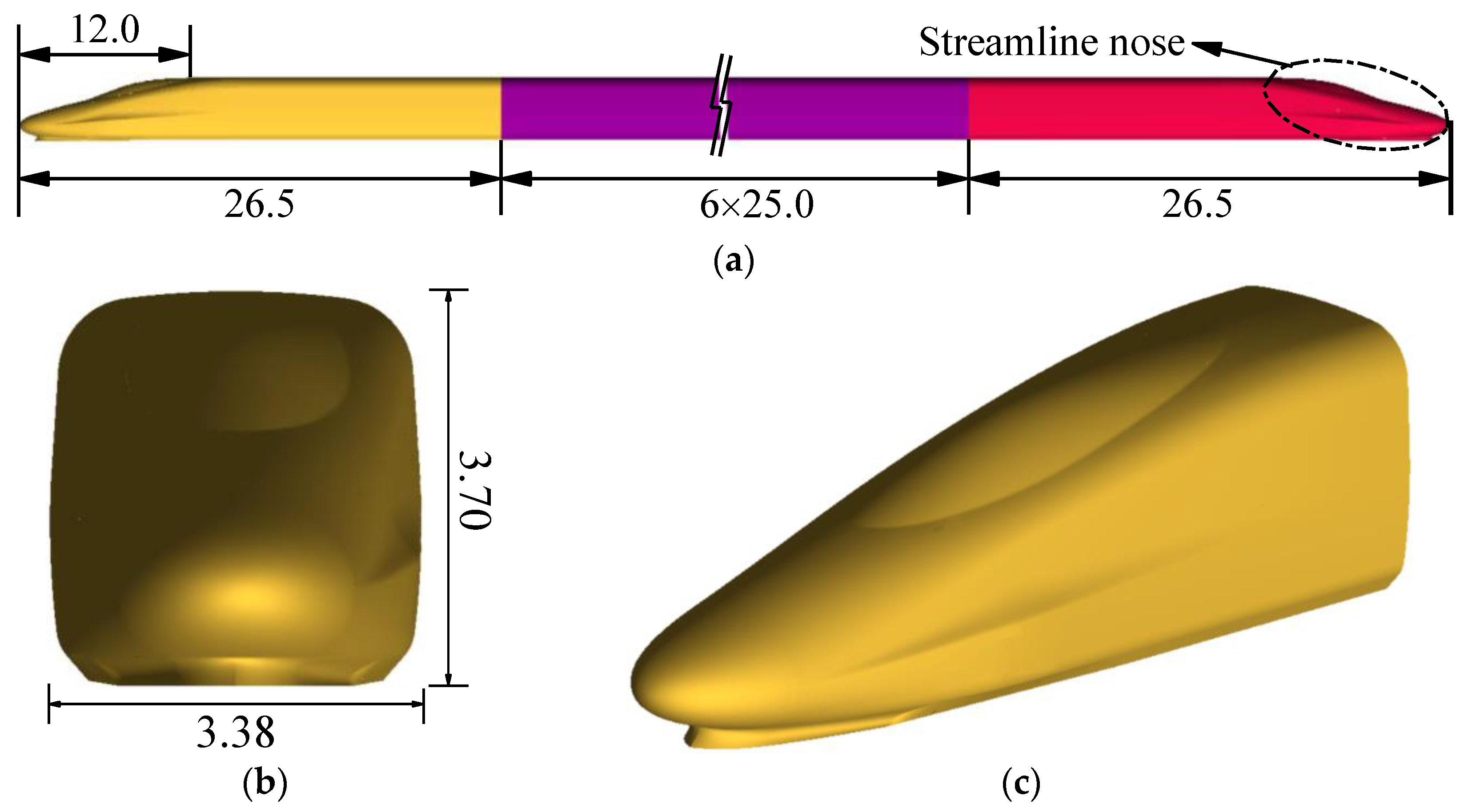
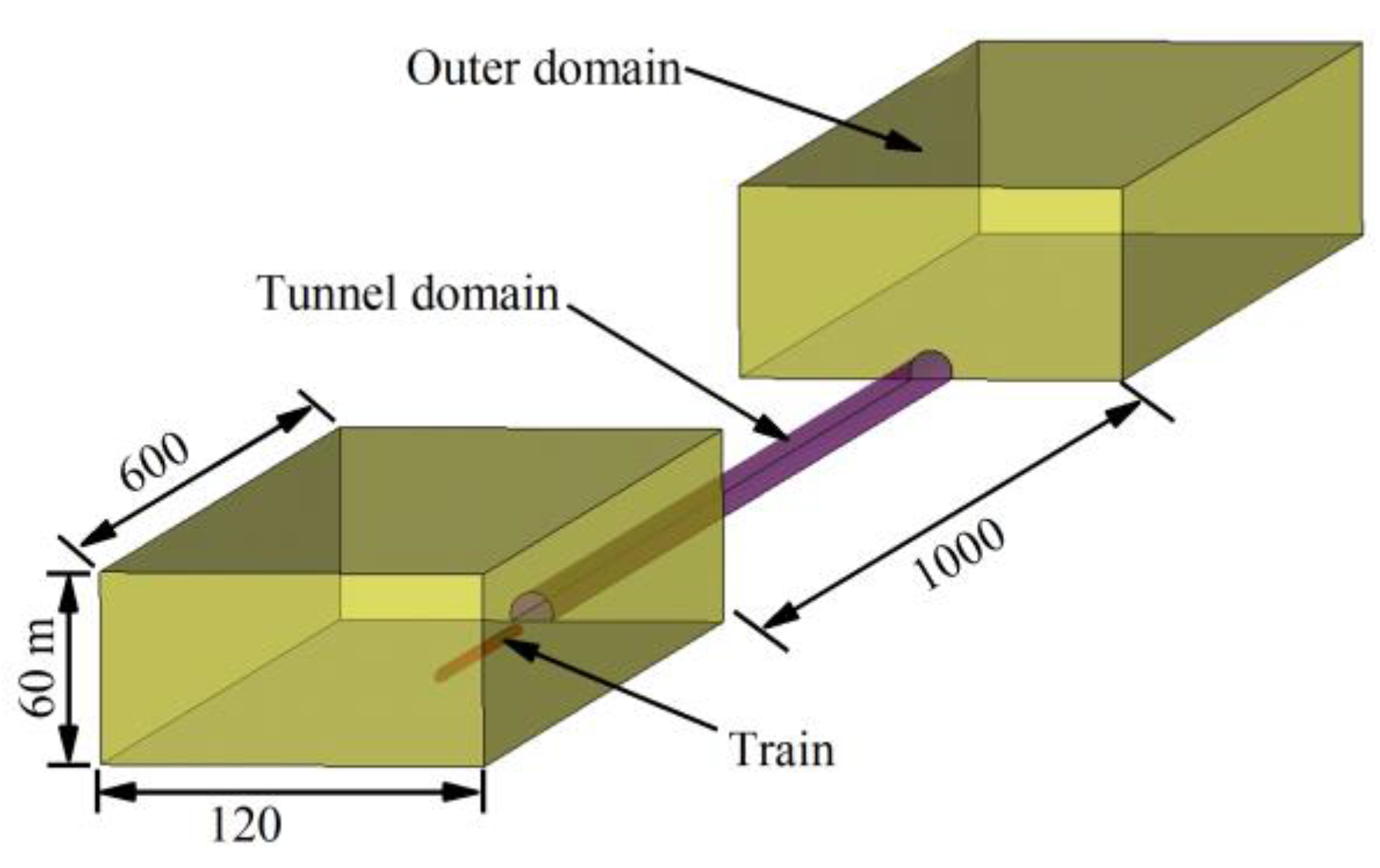
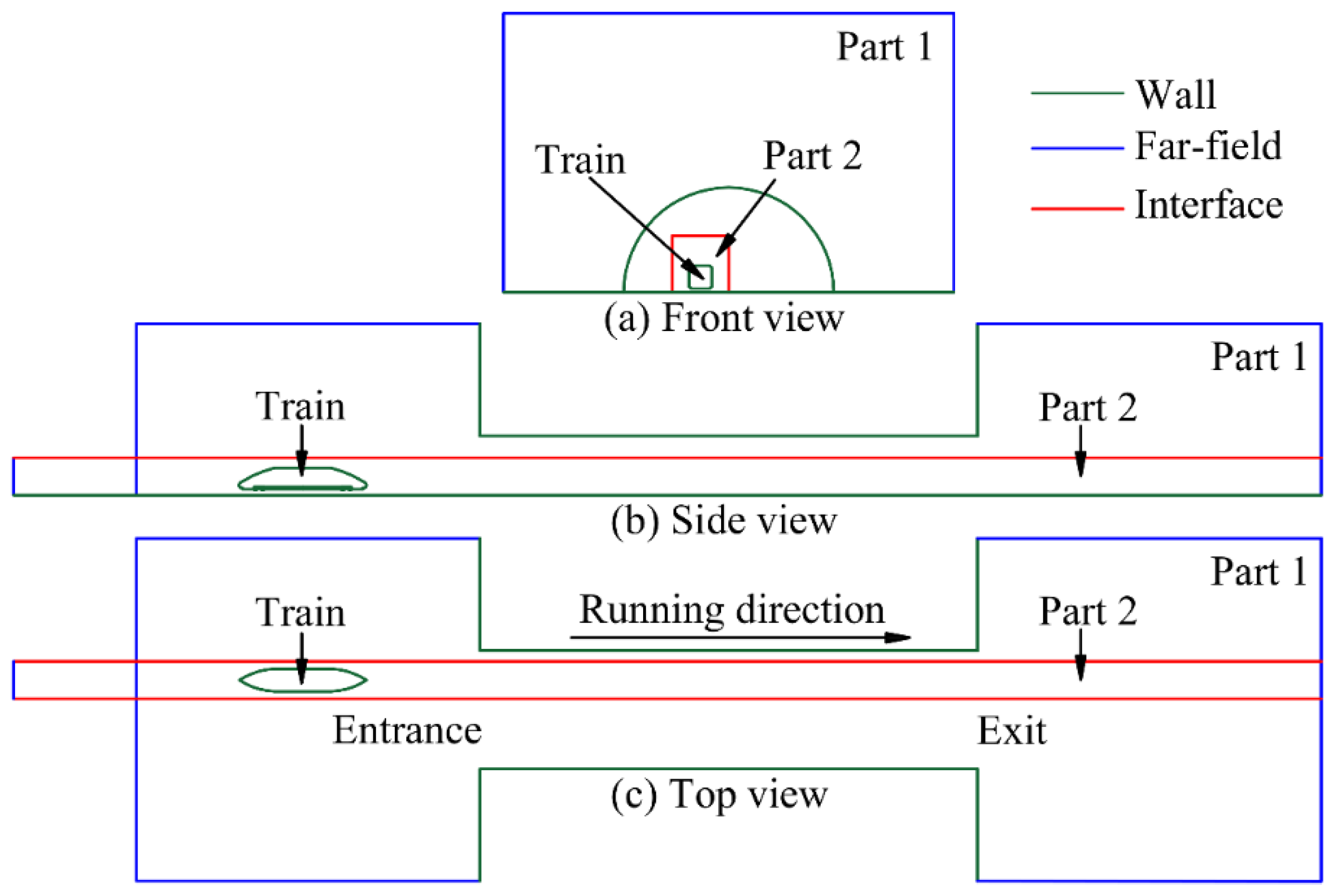
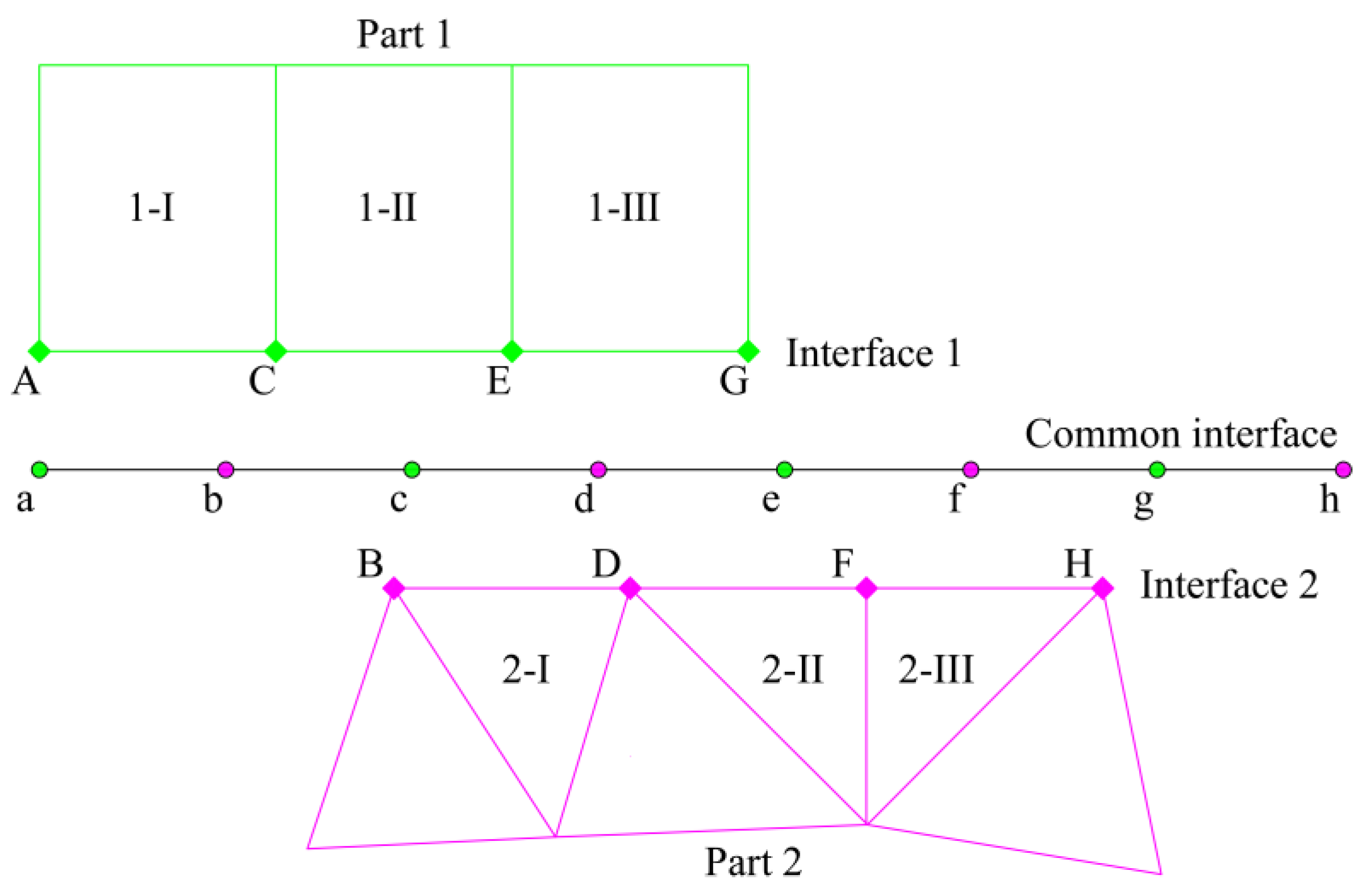
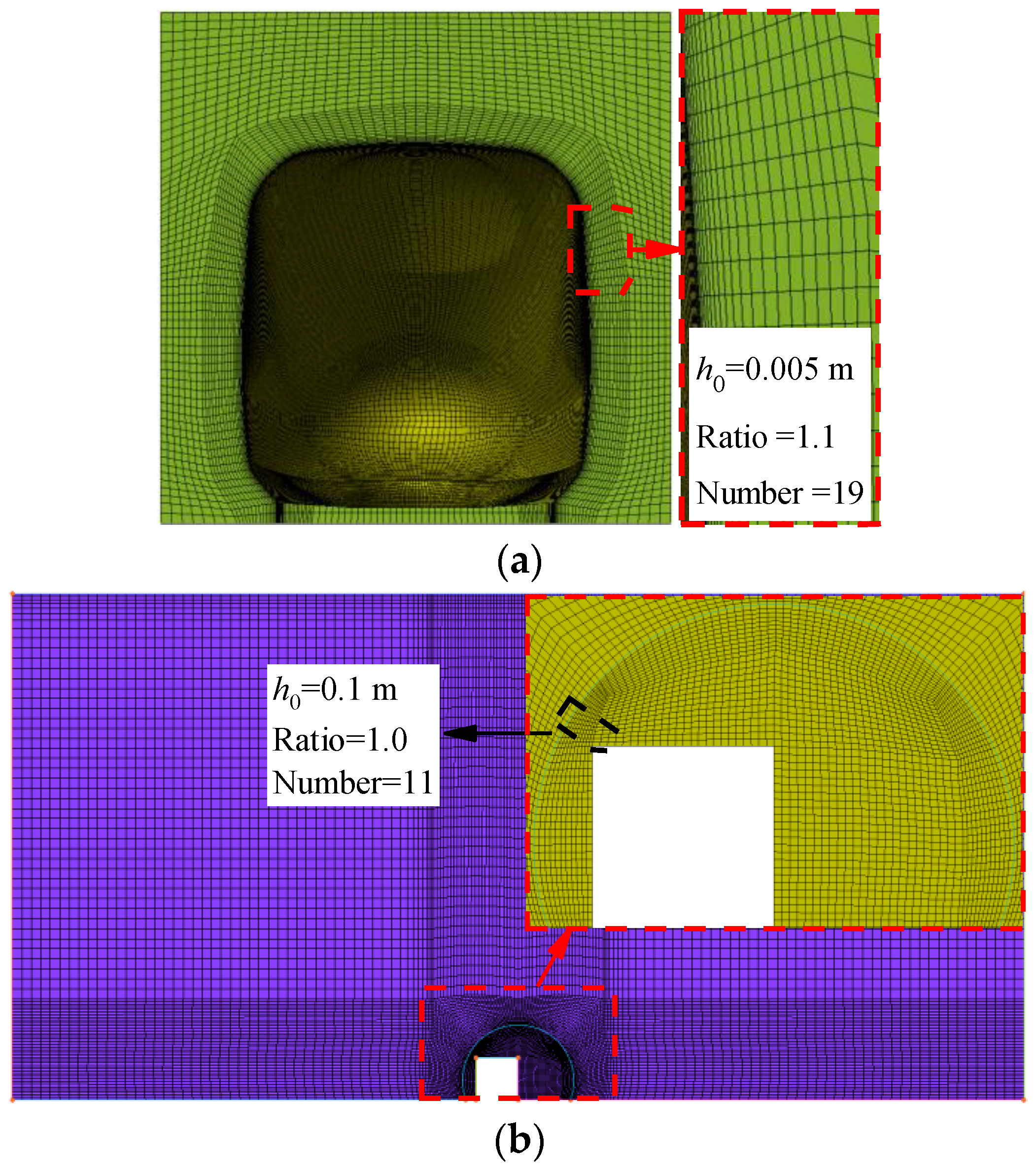
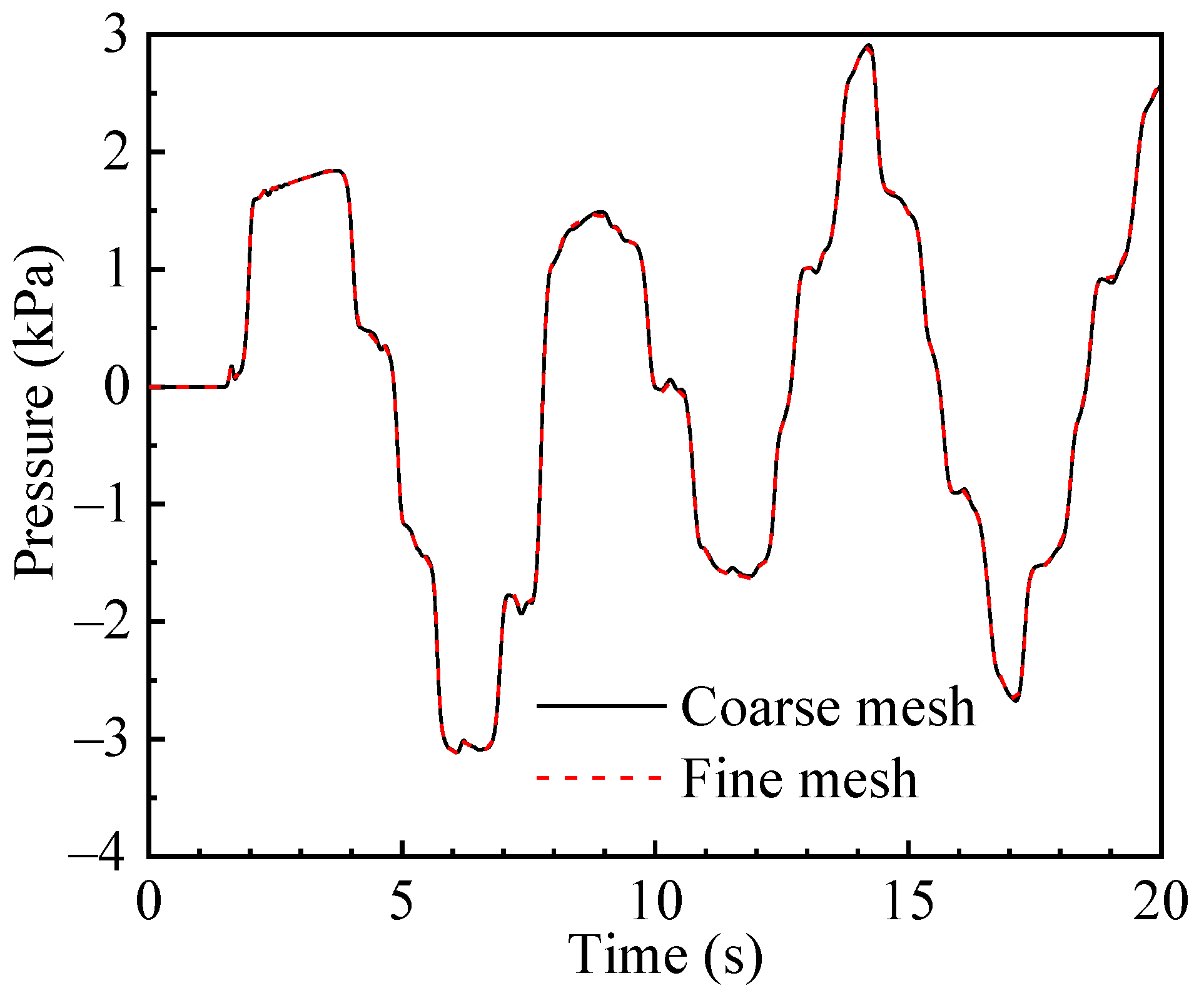
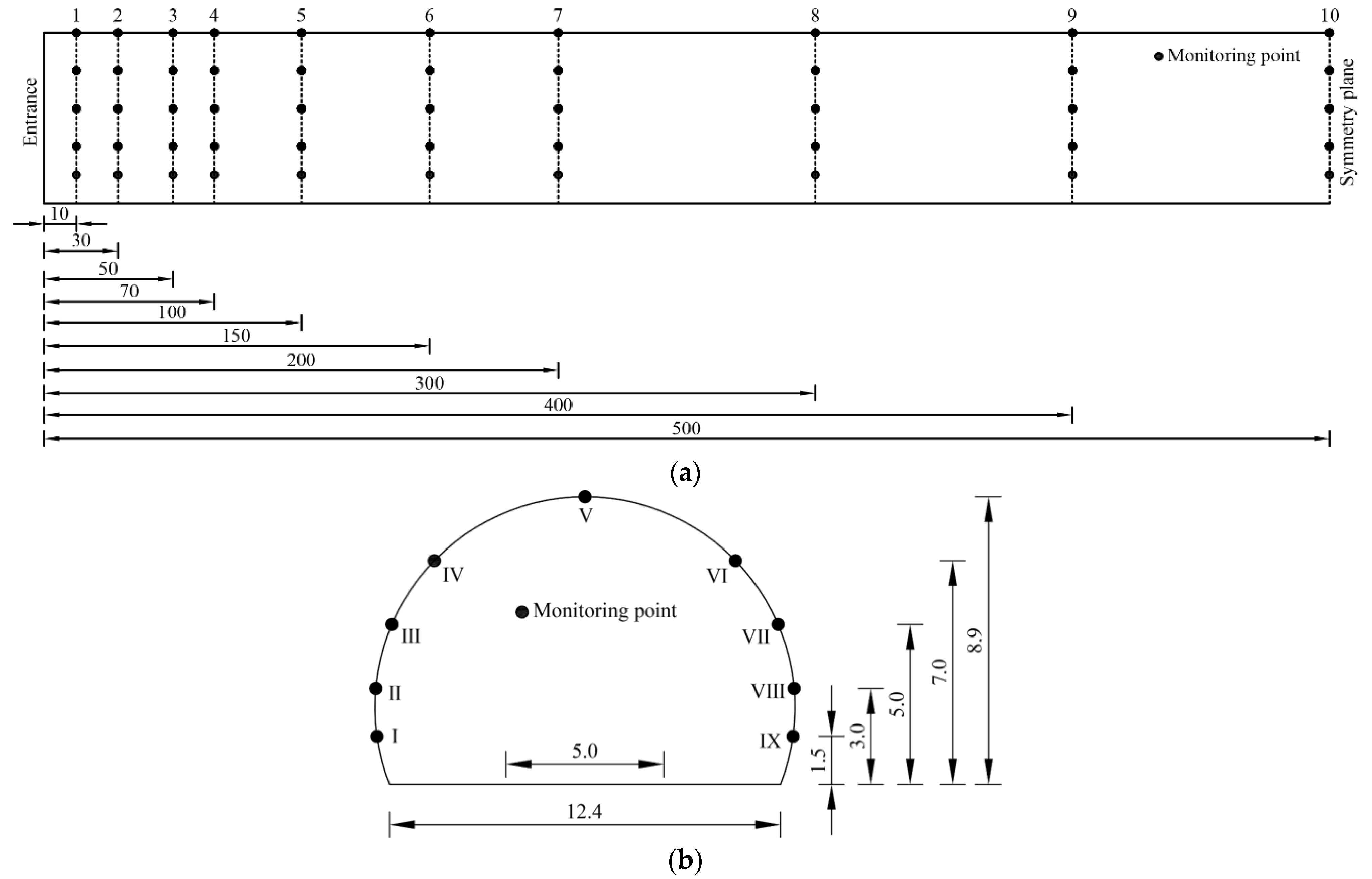
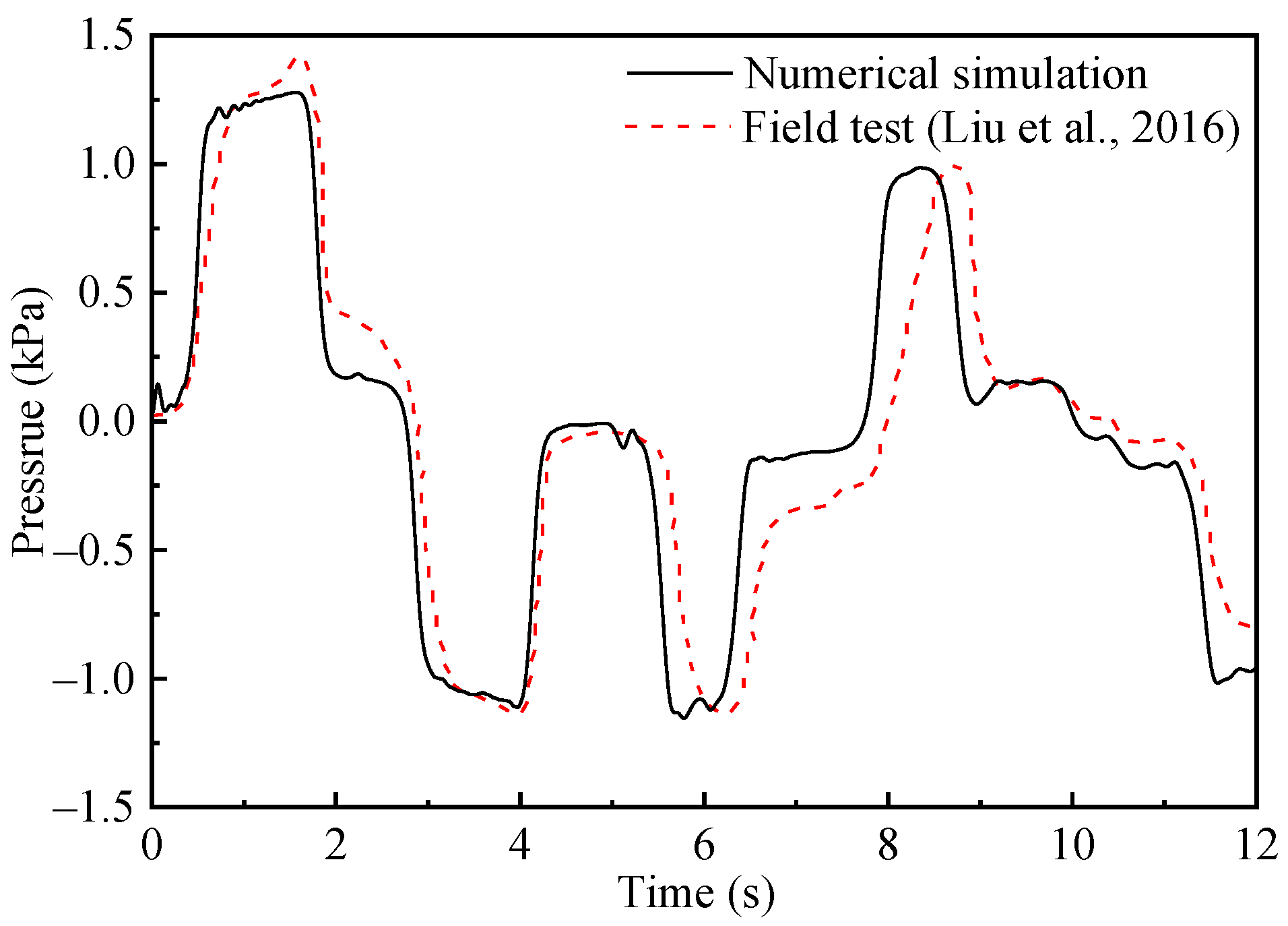

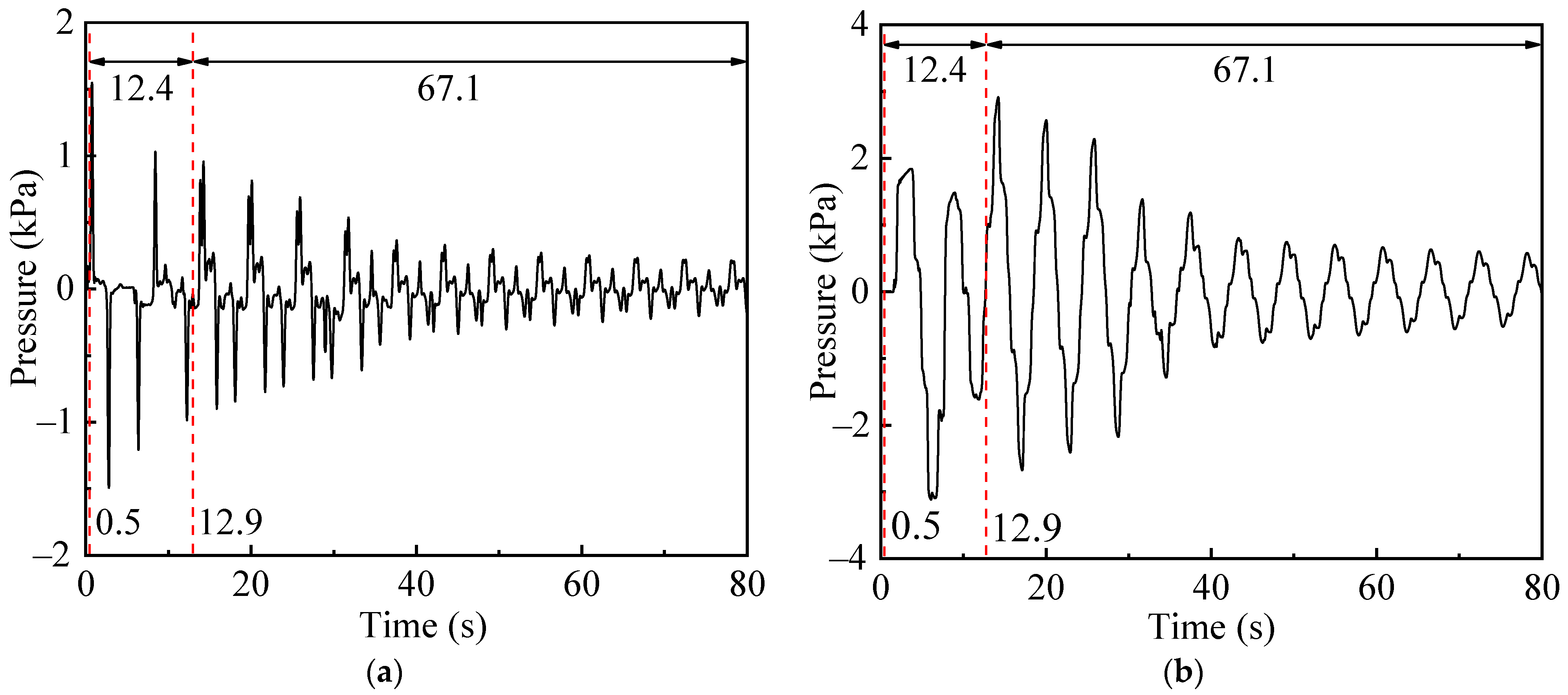

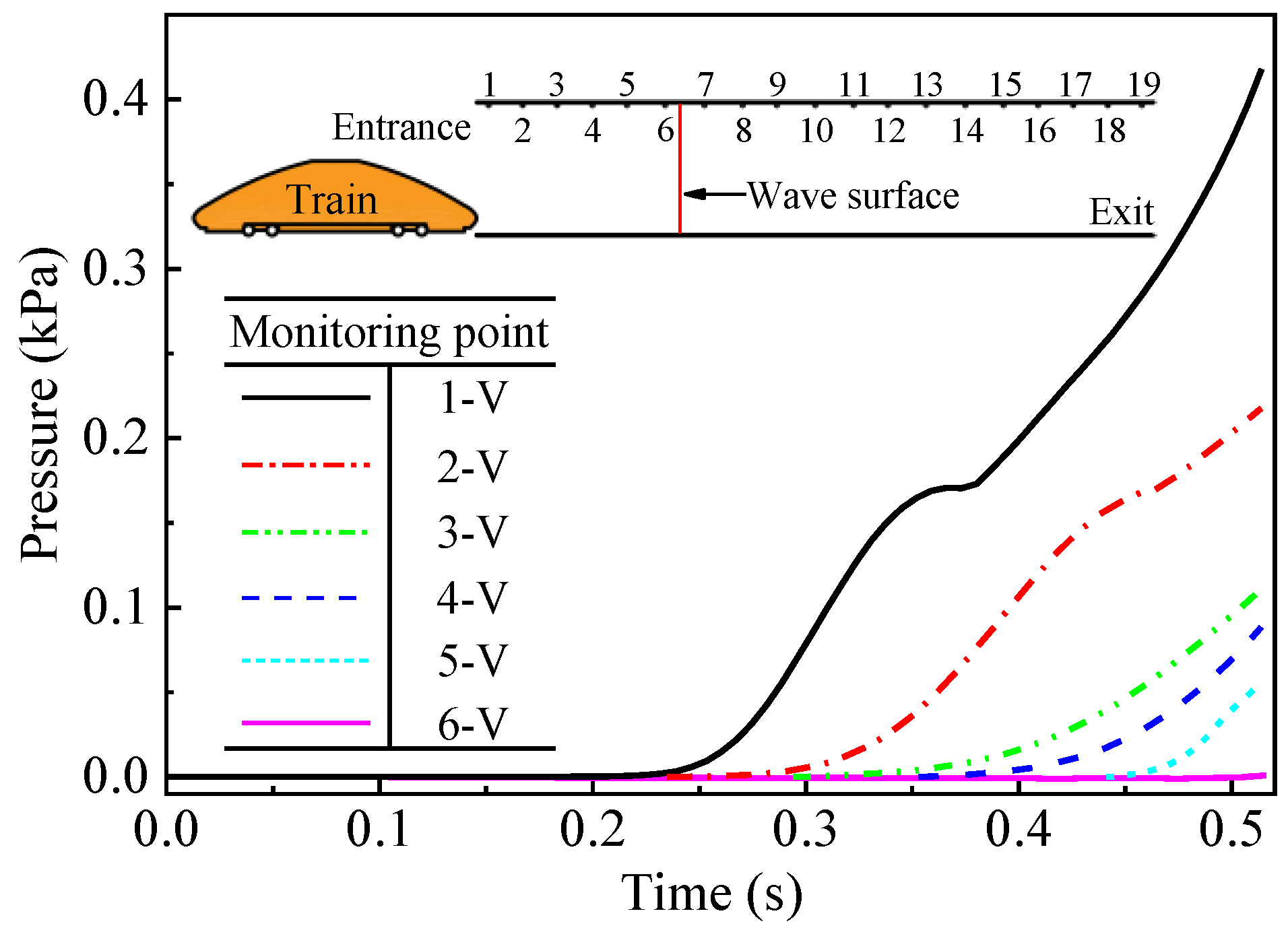
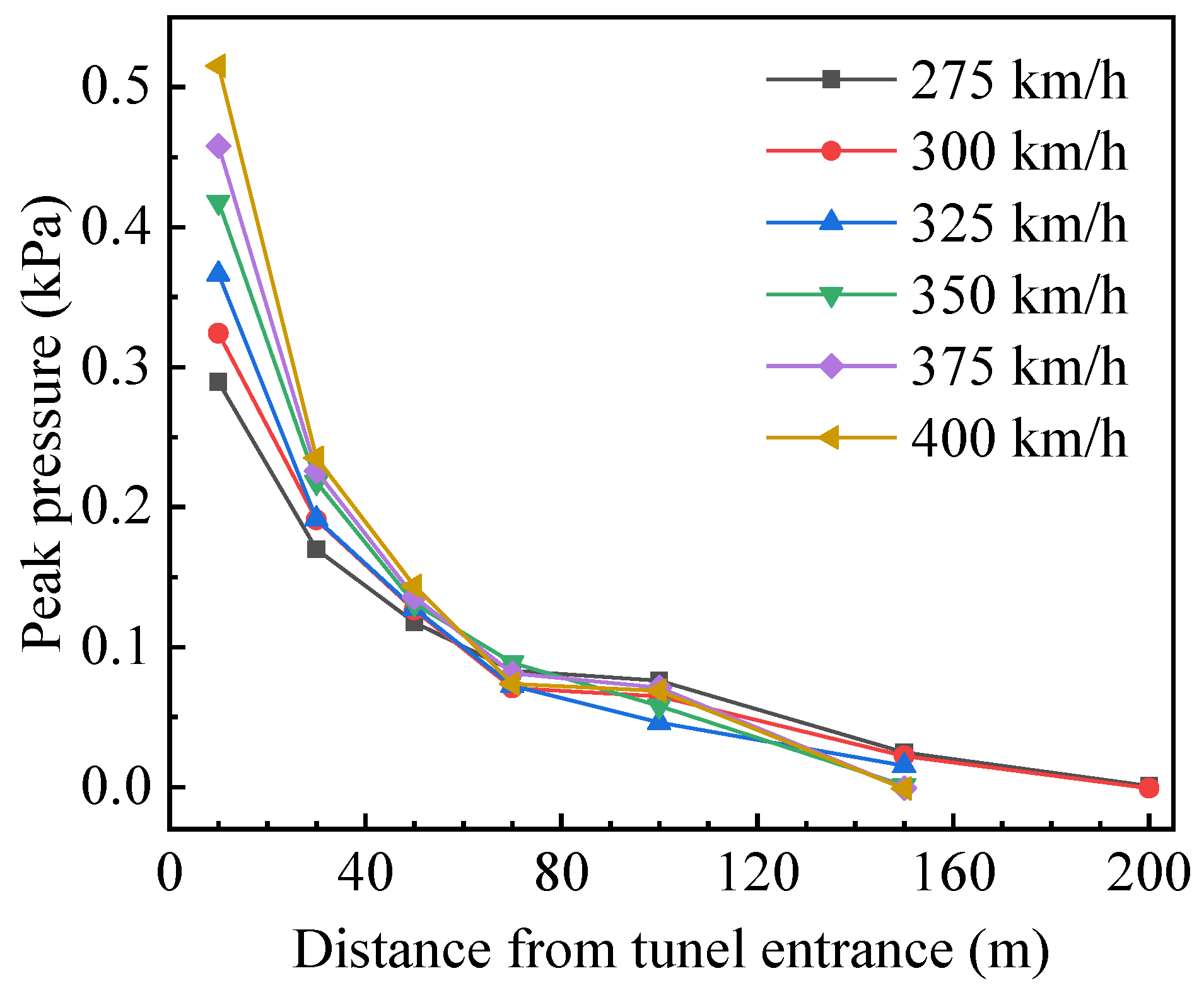


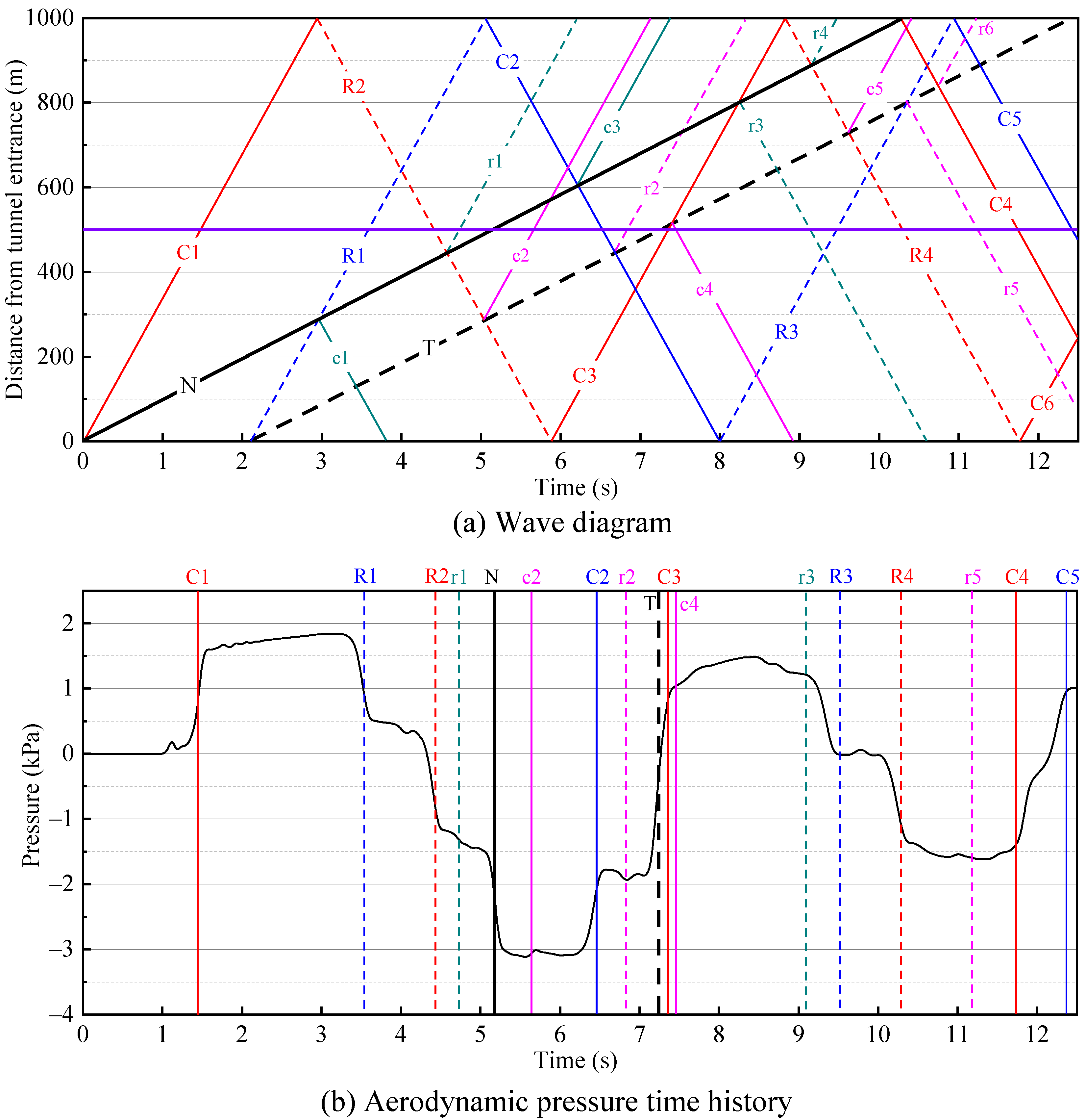

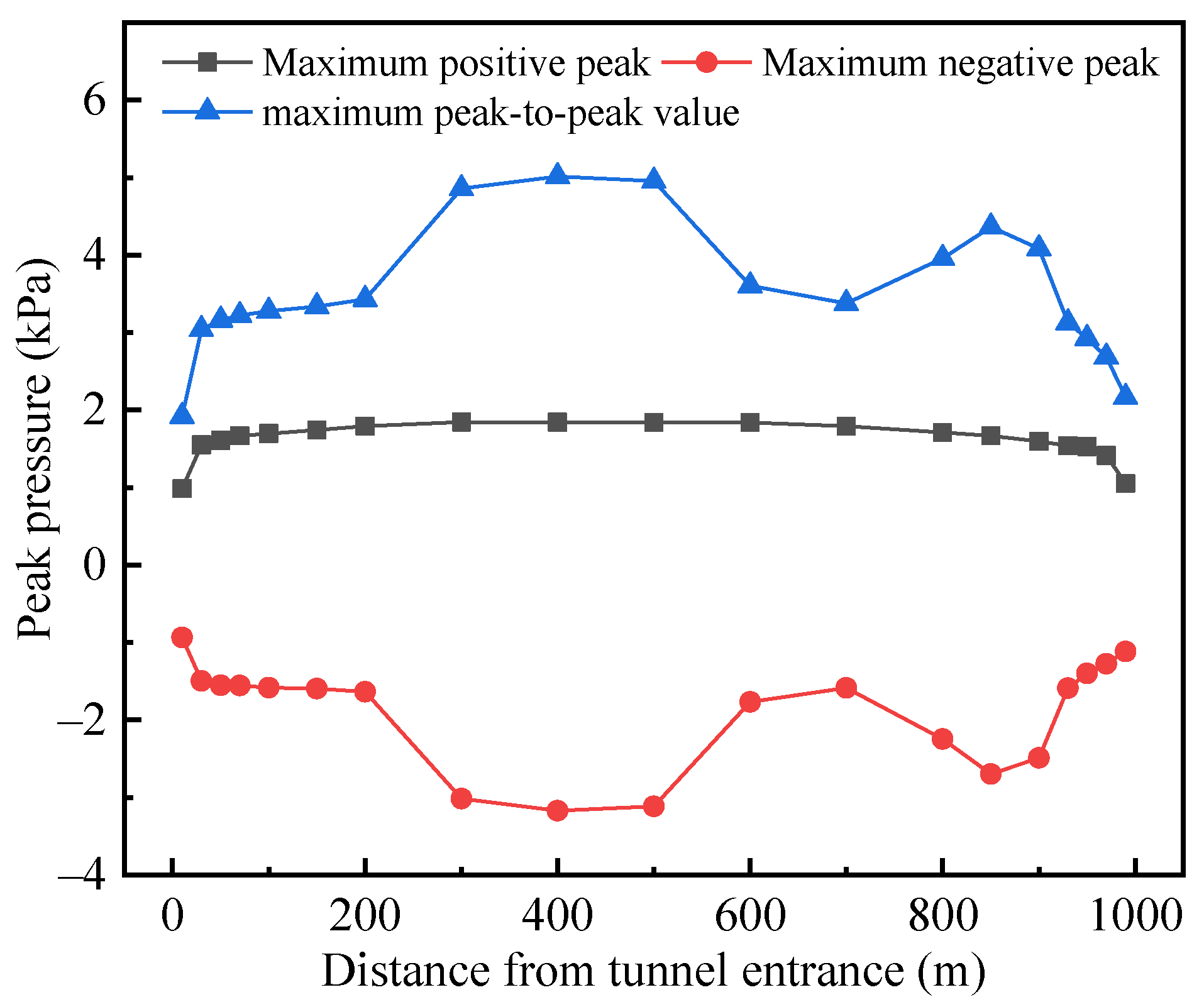
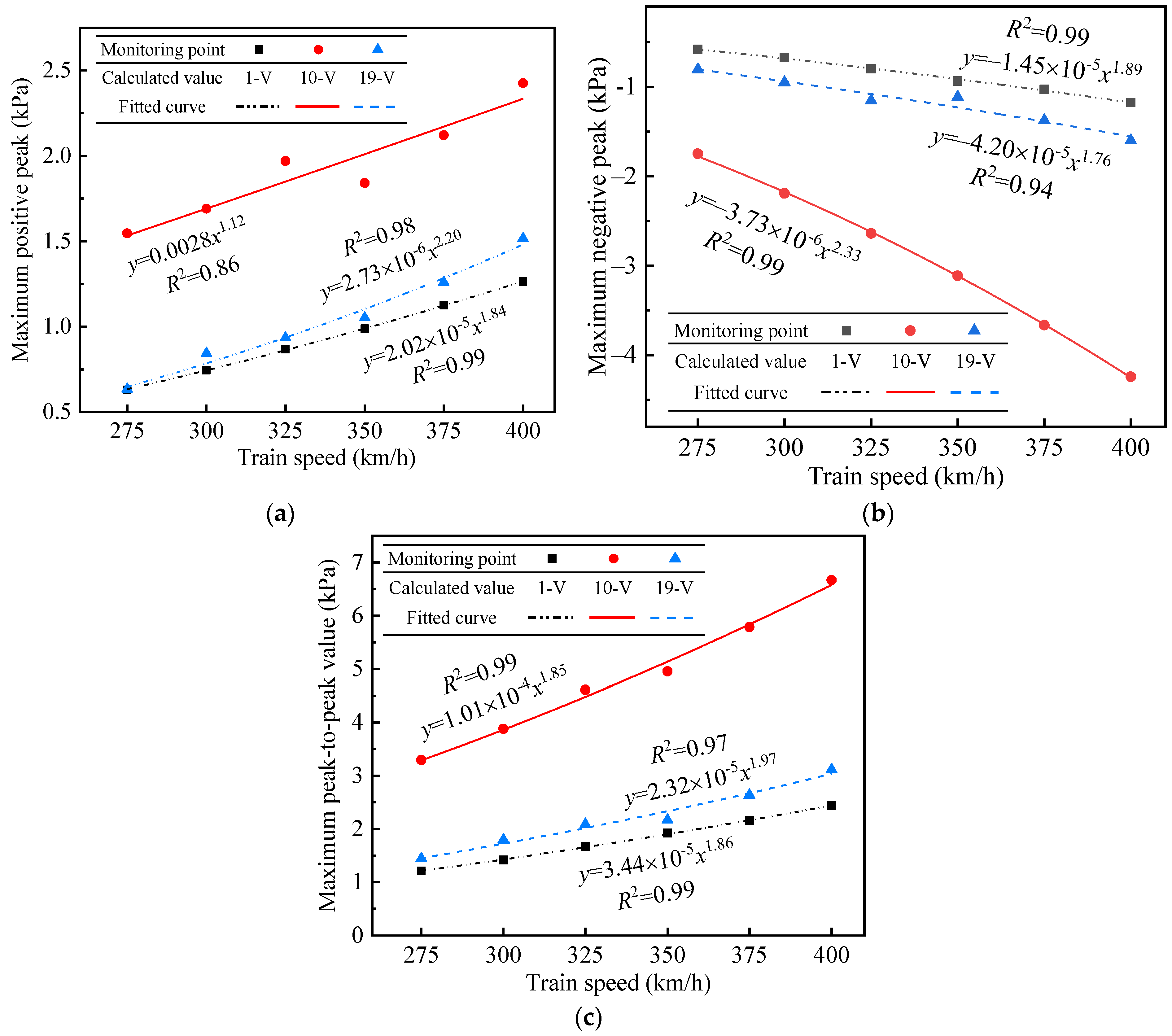
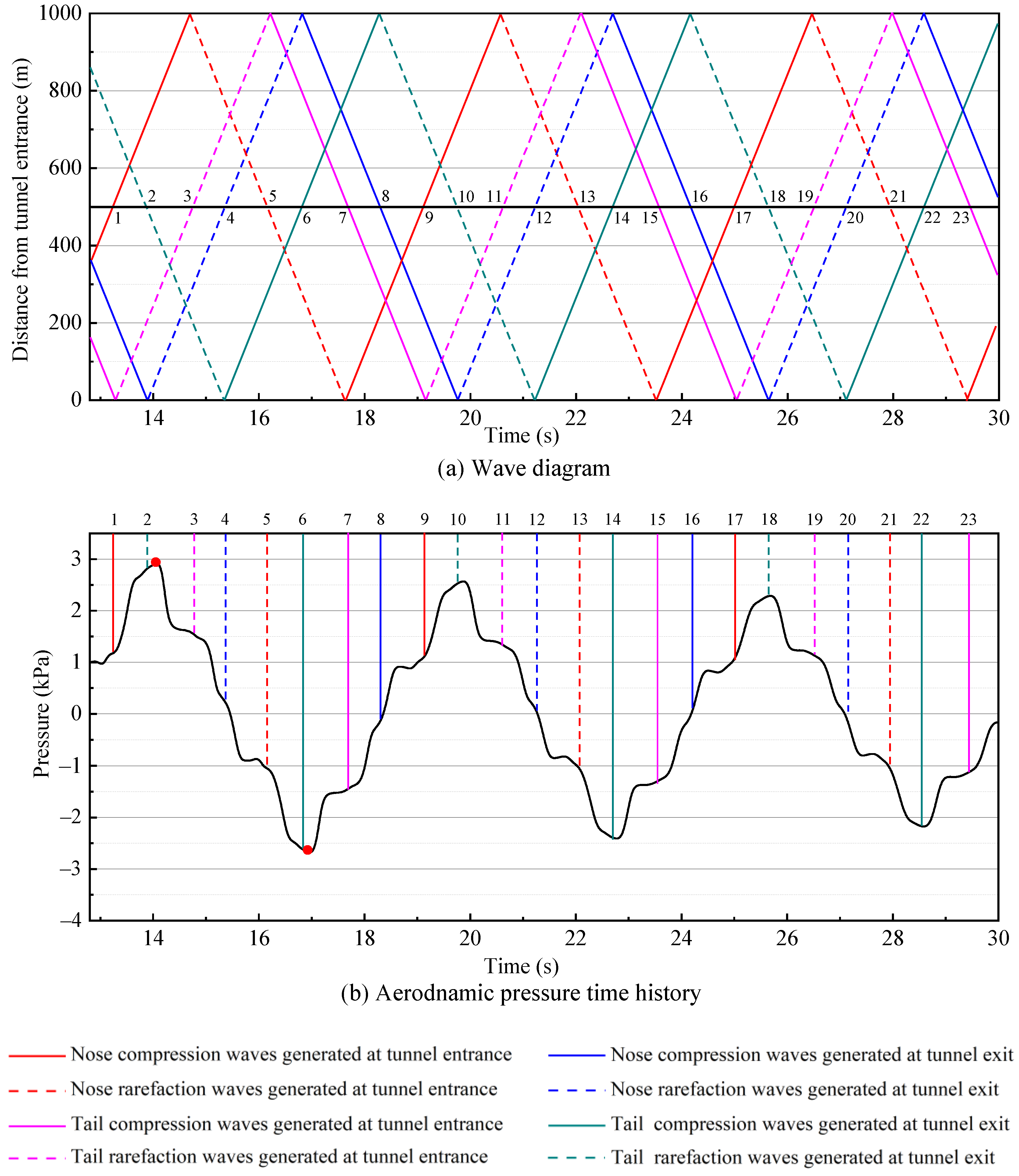


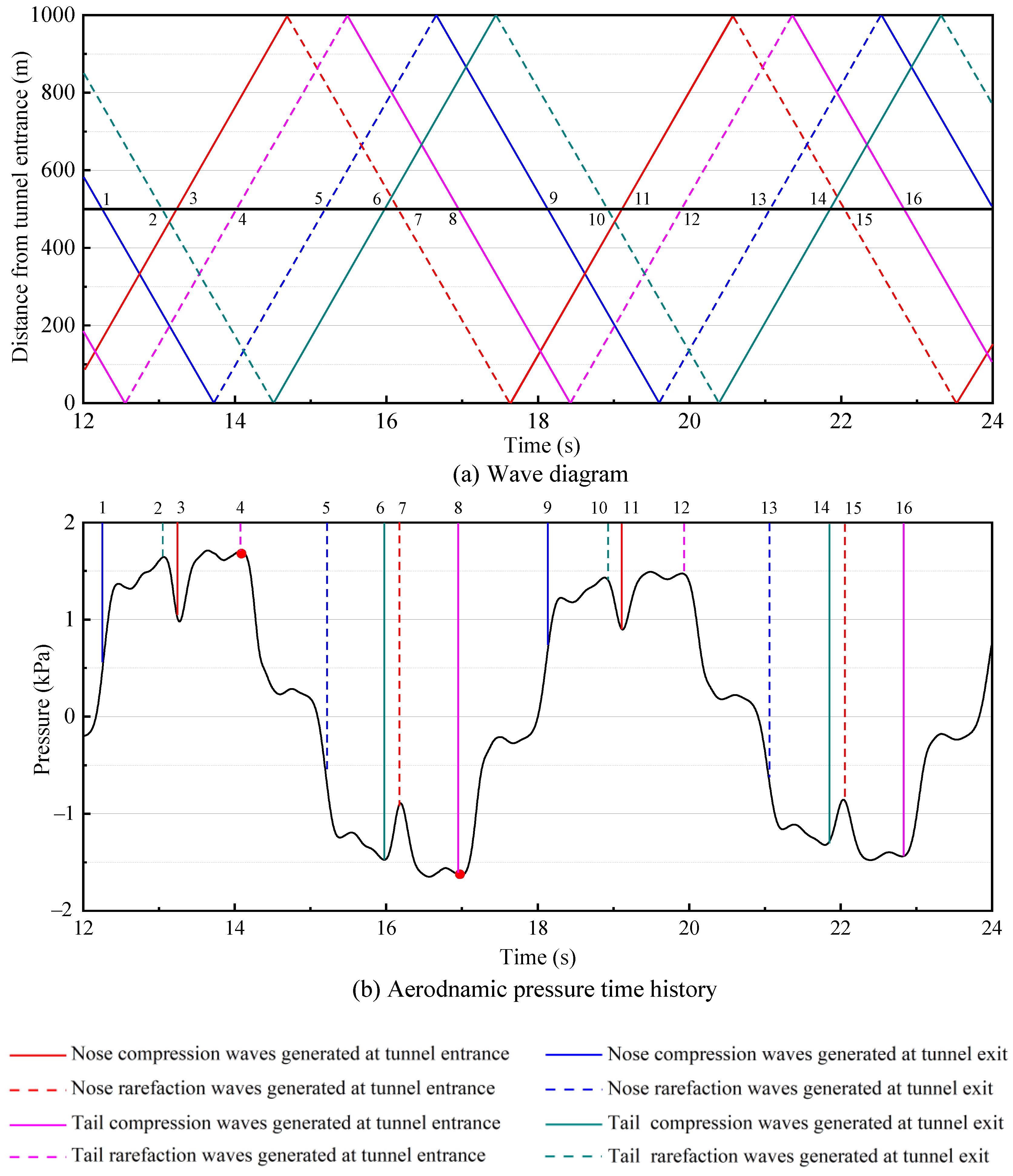
| Train speed (km/h) | 275 | 300 | 325 | 350 | 375 | 400 |
| Propagation distance (m) | 222.55 | 204.00 | 188.31 | 174.86 | 163.20 | 153.00 |
Publisher’s Note: MDPI stays neutral with regard to jurisdictional claims in published maps and institutional affiliations. |
© 2021 by the authors. Licensee MDPI, Basel, Switzerland. This article is an open access article distributed under the terms and conditions of the Creative Commons Attribution (CC BY) license (https://creativecommons.org/licenses/by/4.0/).
Share and Cite
Du, J.; Fang, Q.; Wang, J.; Wang, G. Influences of High-Speed Train Speed on Tunnel Aerodynamic Pressures. Appl. Sci. 2022, 12, 303. https://doi.org/10.3390/app12010303
Du J, Fang Q, Wang J, Wang G. Influences of High-Speed Train Speed on Tunnel Aerodynamic Pressures. Applied Sciences. 2022; 12(1):303. https://doi.org/10.3390/app12010303
Chicago/Turabian StyleDu, Jianming, Qian Fang, Jun Wang, and Gan Wang. 2022. "Influences of High-Speed Train Speed on Tunnel Aerodynamic Pressures" Applied Sciences 12, no. 1: 303. https://doi.org/10.3390/app12010303
APA StyleDu, J., Fang, Q., Wang, J., & Wang, G. (2022). Influences of High-Speed Train Speed on Tunnel Aerodynamic Pressures. Applied Sciences, 12(1), 303. https://doi.org/10.3390/app12010303






